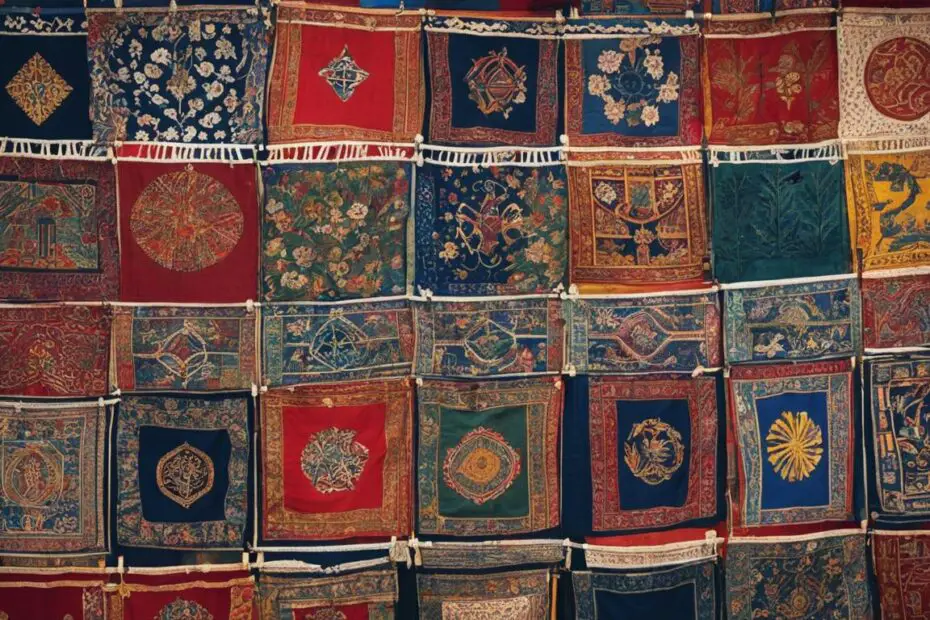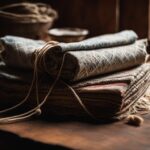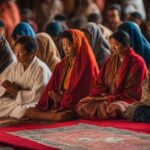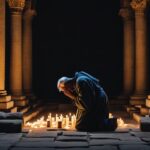The history of prayer cloths is a testament to the enduring power of faith and spirituality. Across different cultures and religions, prayer cloths have held deep significance, serving as a tangible connection between individuals and the divine. These sacred fabrics have evolved over time, becoming symbols of devotion and sources of comfort for millions around the world.
From the Islamic prayer cloth, also known as a prayer rug or sajjadah, to the use of prayer cloths in Christian traditions, the history of these cloths is as diverse as the communities that hold them dear. The origins of prayer cloths can be traced back centuries, with each culture and religion adding their unique customs and practices to this timeless tradition.
Key Takeaways:
- The history of prayer cloths spans across different cultures and religions, reflecting the universal need for spiritual connection.
- Prayer cloths have evolved over time to become symbols of faith and devotion.
- They hold deep spiritual significance and offer comfort and solace to individuals during prayer.
- The Islamic prayer cloth and prayer cloths in Christianity have their own unique origins and practices.
- The symbolism, artistry, and craftsmanship woven into prayer cloths add layers of meaning and guidance in spiritual reflection.
The Islamic Prayer Cloth
The Islamic prayer cloth has a rich historical background intertwined with the traditions of Prophet Muhammad (peace be upon him) and his companions. Its origins date back to the early days of Islam when simplicity prevailed in providing a clean and comfortable space for prayer. Initially, basic mats served this purpose, but they gradually evolved into the beautifully designed prayer cloths seen today.
The ancient traditions of prayer cloths in Islam have been passed down through generations, embodying both physical and spiritual significance. These cloths symbolize an individual’s unwavering commitment to their faith and serve as a dedicated space for prayer and reflection.
Prayer cloths not only offer a clean and purified surface for prayer but also create a sacred space where individuals can connect with the divine. The use of prayer cloths in Islamic rituals is rooted in the belief that these cloths hold a spiritual presence and energy, inviting a deeper connection with Allah.
The intricate designs and patterns woven into the prayer cloths reflect the rich cultural heritage of the Islamic community. Each cloth serves as a testament to the artistry and craftsmanship of skilled artisans who bring these designs to life using techniques such as weaving, embroidery, and printing.
Ancient Traditions and Symbolism
Throughout Islamic history, prayer cloths have held deep symbolic meaning. The geometric shapes and patterns found in these cloths represent order and harmony, reflecting the divine presence in the universe. Colors such as green, blue, red, and gold carry specific significance in accordance with religious traditions.
Furthermore, floral motifs, calligraphic verses, and architectural elements are commonly woven into the fabric, adding layers of symbolism that guide individuals towards spiritual reflection and contemplation during prayer.
“The Islamic prayer cloth represents the beauty of faith, inviting individuals to seek spiritual connection and find solace in their devotion.”
It is important to note that prayer cloths in Islam are not simply objects of decoration but rather cherished possessions that are treated with respect and reverence. They are usually stored in a clean and safe place when not in use.
| Key Features of the Islamic Prayer Cloth | Explanation |
|---|---|
| Intricate Designs | The prayer cloths feature elaborate patterns and motifs that captivate the eye and inspire spiritual contemplation. |
| Symbolic Colors | Colors such as green, blue, red, and gold are carefully chosen for their spiritual significance in Islamic traditions. |
| Ambiance of Devotion | Prayer cloths create an environment conducive to prayer, providing a dedicated space for connecting with Allah. |
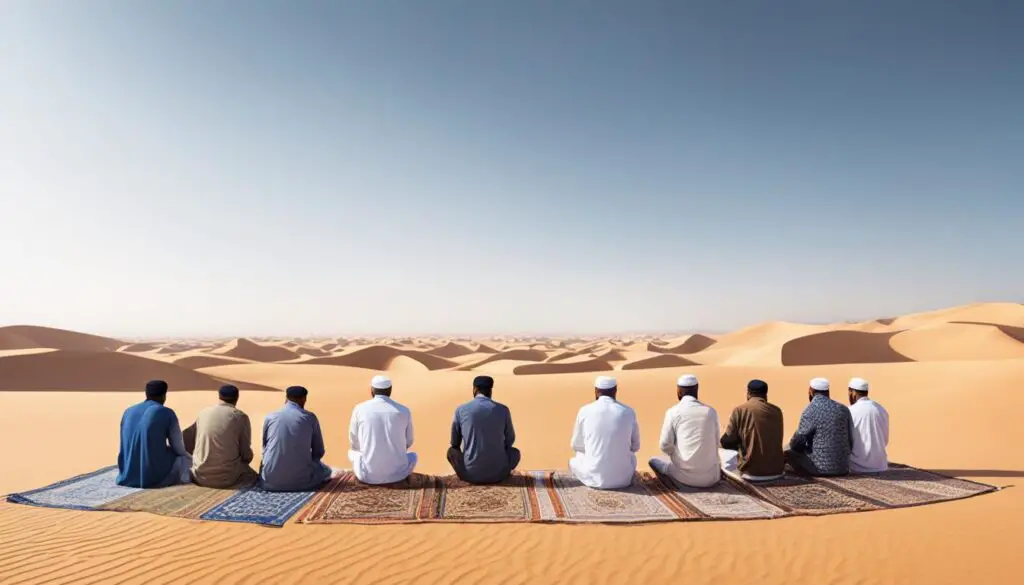
Significance of Prayer Cloths in Christianity
In addition to their significance in various religious traditions, prayer cloths also hold a profound meaning in Christianity. Within the Pentecostal and Methodist traditions, prayer cloths, sometimes known as healing handkerchiefs, are considered to possess the power to heal and provide spiritual comfort. The history of prayer cloths within Christianity can be traced back to biblical accounts, including the stories of Jesus’ miraculous healings and the Apostle Paul’s use of prayer cloths:
“And God was doing extraordinary miracles by the hands of Paul, so that even handkerchiefs or aprons that had touched his skin were carried away to the sick, and their diseases left them and the evil spirits came out of them.” – Acts 19:11-12
These biblical accounts highlight the belief in the spiritual efficacy of prayer cloths and their ability to convey divine healing power. Today, prayer cloths often play a significant role in healing rituals, prayer services, and religious ceremonies.
Christian prayer cloths are frequently blessed by clergy members before being used in religious practices. These blessed prayer cloths are then employed in prayer services or distributed to individuals seeking spiritual healing or comfort. The act of holding or wearing a prayer cloth is seen as a tangible expression of faith and a way to establish a connection with the divine.
Prayer shawls, a type of prayer cloth, also have a deep-rooted history within Christianity. A prayer shawl is a large, rectangular cloth traditionally worn over the shoulders during prayer. It serves as a physical reminder of one’s devotion and provides spiritual solace. The use of prayer shawls can be traced back to ancient Jewish traditions, where they were known as “Tallit” and symbolized the wearer’s dedication to God’s commandments.
Prayer cloths and prayer shawls embody the spiritual devotion and belief in the power of prayer within the Christian faith. Through these sacred textiles, believers seek solace, healing, and a tangible connection to the divine.
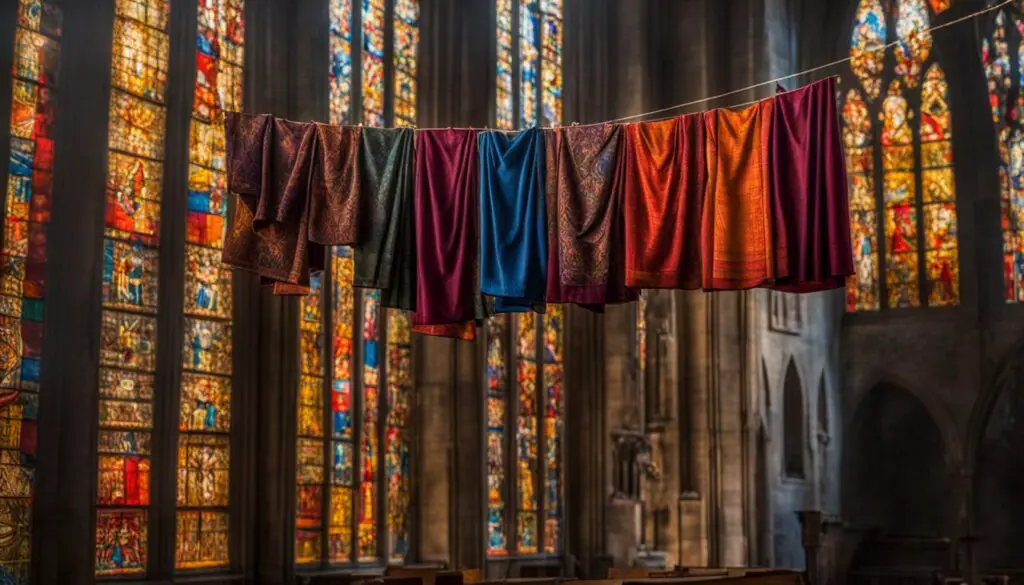
| Key Points | Significance |
|---|---|
| Healing Power | Prayer cloths are believed to possess the power to heal and provide spiritual comfort. |
| Biblical Origins | Biblical accounts, such as Jesus’ miraculous healings and the Apostle Paul’s use of prayer cloths, contribute to their significance in Christianity. |
| Blessing by Clergy | Prayer cloths are often blessed by clergy members before being used in religious practices. |
| Prayer Shawls | Prayer shawls, a type of prayer cloth, have a deep-rooted history in Christianity, symbolizing devotion and providing spiritual solace. |
Cultural and Historical Context of Prayer Cloths
Prayer cloths have a rich cultural and historical context that spans across different civilizations and traditions. These sacred cloths have been used for centuries and hold deep spiritual significance in various cultures worldwide. Beyond their religious connotations, prayer cloths have been regarded as symbols of protection, healing, and a powerful connection to the divine.
The use of prayer cloths has evolved and adapted over time, reflecting the changing cultural contexts in which they are employed. Each culture brings its own unique traditions and customs to the practice of using prayer cloths, incorporating diverse designs, symbols, and rituals that add depth and meaning to this spiritual practice.
One of the key factors that contribute to the historical context of prayer cloth use is the evolution of the practice itself. Prayer cloths have undergone transformations, both in terms of their physical appearance and their purpose. From simple pieces of fabric to intricately woven textiles, prayer cloths have evolved to represent the evolving spiritual needs and beliefs of communities throughout history.
Through centuries, prayer cloths have served as tangible reminders of faith, offering solace, and providing a physical connection to the divine. They have been used in religious ceremonies, healing rituals, and personal prayer, bridging the gap between the spiritual and the physical realm.
To further explore the cultural and historical context of prayer cloths, let’s take a look at a comprehensive table highlighting their evolution in different civilizations:
| Culture | Time Period | Prayer Cloth Characteristics |
|---|---|---|
| Islamic | 7th century CE – present | Ornate prayer rugs and sajjadahs with intricate geometric patterns and calligraphic verses, symbolizing unity and reverence. |
| Christian | 1st century CE – present | Prayer shawls and healing handkerchiefs, often anointed by clergy members, believed to carry healing and spiritual blessings. |
| African Traditional Religions | Ancient times – present | Colorful and patterned textiles used in ancestral worship and spiritual rituals, symbolizing ancestral or deity connection. |
| Buddhist | 3rd century BCE – present | Prayer flags and banners adorned with auspicious symbols and mantras, representing prayers for peace, harmony, and enlightenment. |
The historical context of prayer cloth use provides a deeper understanding of the significance and enduring practice of using these sacred textiles. By exploring different cultural perspectives and the evolution of prayer cloth traditions, we gain insight into the profound impact of prayer cloths on individuals, communities, and religious practices throughout history.
Next, we will explore the symbolism and design of prayer cloths, delving into the intricate patterns and motifs that hold profound spiritual meaning for those who use them.
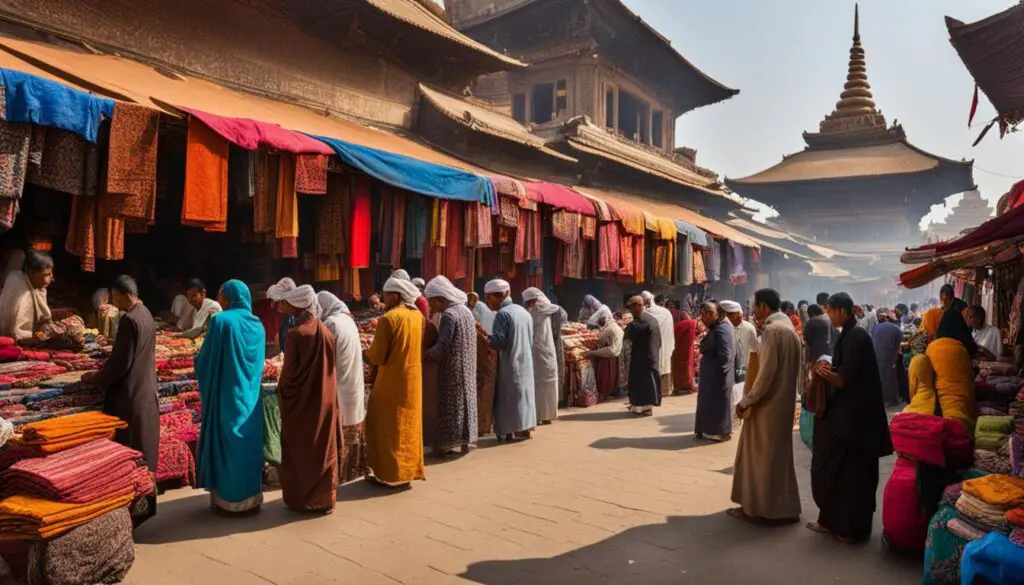
Symbolism and Design of Prayer Cloths
Prayer cloths are not just simple pieces of fabric, but intricate creations filled with rich symbolism and deep spiritual meaning. Every pattern and motif woven into the cloth carries a message, guiding the praying individual towards spiritual reflection and connection to the divine.
Geometric shapes play a significant role in prayer cloth design, representing order, balance, and harmony. These shapes serve as symbolic elements that remind believers of the divine order and the interconnectedness of all creation. From intricate mandala patterns to interlocking tessellations, geometric designs evoke a sense of unity and integration.
Colors also hold powerful symbolism in prayer cloths. Green signifies growth, renewal, and fertility, symbolizing the flourishing of one’s faith. Blue represents peace, tranquility, and the vastness of the divine, encouraging individuals to find solace and serenity in prayer. Red embodies passion, sacrifice, and spiritual devotion, reminding believers of the transformative power of their faith. Gold represents divinity, enlightenment, and the eternal, reflecting the highest spiritual aspirations.

Floral motifs are commonly found in prayer cloths, symbolizing beauty, life, and abundance. These delicate designs reflect the diversity and interconnectedness of the natural world, reminding individuals of the divine presence in every living thing.
Calligraphic verses are another integral part of prayer cloth design. These sacred texts, often taken from religious scriptures, serve as a visual representation of divine wisdom and guidance. Just as the words in the cloth are carefully chosen, they resonate with the believer and provide spiritual nourishment during prayer.
Architectural elements, such as minarets, domes, or holy places, can also be seen in prayer cloths. These elements symbolize sacred spaces, transcending physical boundaries and inviting individuals to experience the divine presence in their own prayer journey.
With a tapestry of symbolism woven into every prayer cloth, believers are guided towards spiritual reflection, unity, and connection with the divine.
Craftsmanship and Artistry of Prayer Cloths
The creation of prayer cloths is a testament to the artistry and craftsmanship of skilled artisans who utilize various techniques such as weaving, embroidery, and printing to bring these sacred designs to life. Each prayer cloth serves as a reflection of the rich cultural heritage of the community it belongs to, celebrating diversity in designs and traditions. From the vibrant Moroccan-inspired geometric patterns to the intricate motifs found in elaborate Persian rugs, prayer cloths showcase the unique artistic expressions of different cultures.
By incorporating elements of fine craftsmanship and intricate details, prayer cloths capture the essence of faith and devotion. The meticulous weaving and embroidery techniques contribute to the intricate beauty of the designs, evoking a sense of reverence and spirituality. Every stitch represents a labor of love, an act that honors both the cloth and the divinity it symbolizes.
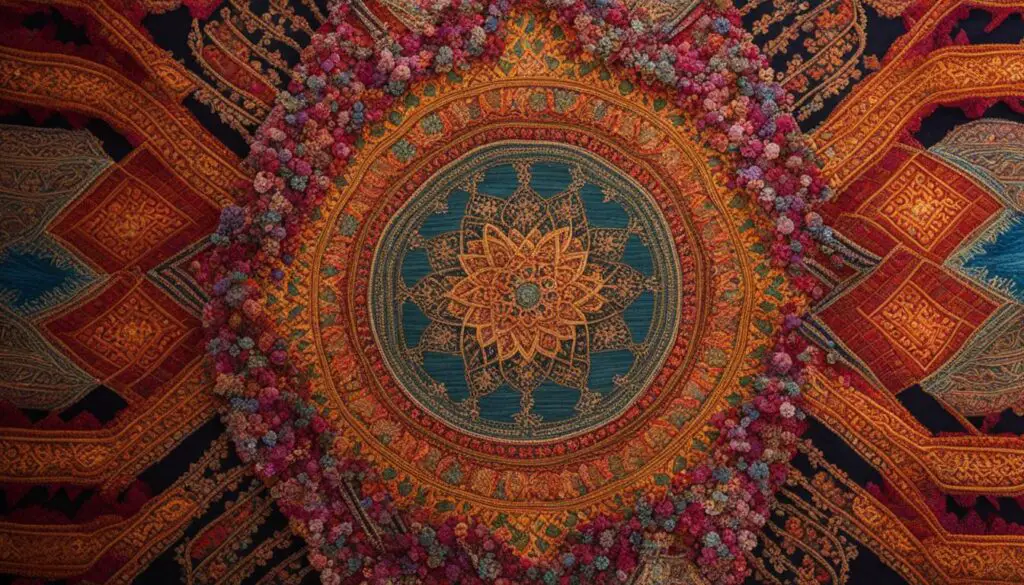
Artistry and craftsmanship in prayer cloths not only showcase the individual talent of artisans but also remind us of the universality of faith. These masterpieces transcend cultural boundaries, inviting people of diverse backgrounds to find solace and connection in the beauty of prayer. The intricate patterns and symbolism woven into the fabric serve as a bridge between cultures, allowing individuals to appreciate the artistry while deepening their understanding of different spiritual traditions.
The table below presents a comparison of prayer cloth designs from various cultures, highlighting the diversity in their artistic expressions.
| Prayer Cloth Culture | Design Characteristics | Symbols and Motifs |
|---|---|---|
| Moroccan | Vibrant geometric patterns | Islamic calligraphy, tile motifs |
| Persian | Intricate floral patterns | Symbolic animals, mythical creatures |
| Indian | Rich color palette, intricately woven borders | Hindu deities, lotus flowers |
| African | Bold and bright designs | Adinkra symbols, tribal motifs |
Through their breathtaking artistry and cultural significance, prayer cloths continue to inspire a sense of awe and devotion. These remarkable creations remind us of the power of art to connect people, celebrate diversity, and foster a deeper understanding of each other’s faith traditions. With their intricacy and symbolic beauty, prayer cloths exemplify the remarkable fusion of art and spirituality.
Proper Usage and Etiquette of Prayer Cloths
Using a prayer cloth involves observing certain usage and etiquette guidelines to uphold the spiritual integrity of the practice. It is essential to approach the prayer cloth with reverence, showing respect for the sacred nature it represents. Here are some key considerations when using prayer cloths:
Placement and Alignment
When using a prayer cloth, it is important to place it on a clean and purified surface. This signifies the purity and sanctity of the act of prayer. Additionally, the prayer cloth should be aligned with the prayer direction, symbolizing the unity of the praying community. By aligning the cloth, individuals demonstrate their commitment to the collective spiritual practice.
Purity and Cleansing
Purity and cleanliness are fundamental aspects of using a prayer cloth. Before engaging in prayer, it is crucial to ensure personal hygiene. This includes performing ablutions or cleansing rituals according to one’s religious traditions. Handling the prayer cloth with clean hands and free from impurities is essential to maintain its sacredness and the spiritual connection it represents.
Show Respect
Respecting the prayer cloth is an integral part of the prayer experience. While using the cloth, it should be handled with care and reverence. Each fold, touch, or adjustment should be made mindfully, demonstrating appreciation for its symbolic significance. Proper storage and protection of the prayer cloth outside of prayer time also show respect for its sacred nature.
“Show respect to the prayer cloth as you would to the divine presence it represents, for it is a sacred link between you and the divine.”
By following these guidelines for proper usage and etiquette, individuals can enhance their prayer experience and deepen their spiritual connection. The prayer cloth serves as a physical tool to assist in the spiritual journey, reminding individuals of their faith and fostering a sense of unity within the community.
| Guidelines for Proper Usage and Etiquette |
|---|
| 1. Place the prayer cloth on a clean and purified surface |
| 2. Align the prayer cloth with the prayer direction |
| 3. Ensure personal hygiene and cleanliness |
| 4. Handle the prayer cloth with respect and care |
| 5. Properly store the prayer cloth when not in use |
Benefits of Using Prayer Cloths
Using a prayer cloth offers numerous benefits that enhance the prayer experience. These benefits include:
1. Enhancing Comfort
The soft and comfortable surface of a prayer cloth provides cushioning, eliminating discomfort when kneeling on hard or cold floors. This allows individuals to focus on their prayers without any physical distractions. The comforting texture of the cloth creates a conducive environment for deep spiritual reflection.
2. Aiding Focus and Concentration
The tactile experience of holding and touching a prayer cloth helps to enhance focus and concentration during prayers. As individuals feel the texture of the cloth in their hands, it serves as a reminder to remain present and fully engaged in the act of prayer. The cloth acts as a grounding element, enabling individuals to immerse themselves in spiritual contemplation.
3. Maintaining Hygiene
Prayer cloths act as personal barriers, ensuring a clean and hygienic surface for prayer. This is particularly beneficial in public spaces like mosques or outdoor prayer gatherings, where cleanliness might be a concern. By using a prayer cloth, individuals can maintain their personal hygiene and ensure a pure and sanctified space for worship.
| Benefits of Using Prayer Cloths |
|---|
| Enhancing Comfort |
| Aiding Focus and Concentration |
| Maintaining Hygiene |
Using a prayer cloth during prayers not only provides practical advantages but also enhances the overall spiritual experience. The combination of comfort, focus, and cleanliness helps individuals connect more deeply with their faith and create a sacred space for their spiritual journey.
Pros and Cons of Prayer Cloths
Prayer cloths offer numerous advantages that enhance the prayer experience and strengthen one’s spiritual connection. These cloths provide a physical and visual reminder of an individual’s devotion, serving as a tangible symbol of their faith. With their intricate designs and symbolic elements, prayer cloths create a sacred ambiance, helping individuals focus their thoughts and intentions during prayer.
Furthermore, prayer cloths have the potential to foster unity within a faith community. When individuals come together, each with their prayer cloths, it creates a sense of collective devotion and shared spirituality. The act of using prayer cloths collectively can strengthen bonds and deepen connections among believers.
“Prayer cloths serve as tangible reminders of our faith, grounding us in our spiritual practices and strengthening our connection with God.”
However, it is essential to acknowledge the criticism and controversies surrounding prayer cloths, as with any religious practice. Some argue that excessive focus on the physical cloth may lead to a loss of focus on the true essence of prayer. Critics also contend that placing too much importance on the cloth itself can result in superficiality and distract from the spiritual intent behind prayer.
While prayer cloths have their advantages, it is crucial to strike a balance between revering the cloth and centering one’s attention on the spiritual intent behind its usage. The cloth should serve as a tool to facilitate connection and devotion, rather than becoming the sole object of veneration.
Ultimately, the benefits of using prayer cloths can be maximized when coupled with a sincere and heartfelt engagement in prayer, where the cloth acts as a physical aid rather than the sole focus. By maintaining this perspective, individuals can fully embrace the advantages of prayer cloths while remaining aligned with the true essence of prayer.
The Advantages and Criticisms of Prayer Cloths
| Advantages | Criticisms |
|---|---|
|
|
Conclusion
Prayer cloths have a rich history that spans across cultures and religions. From the Islamic prayer cloth to the use of prayer cloths in Christianity, these sacred garments hold deep spiritual significance and serve as powerful symbols of faith and devotion.
The intricate symbolism, artistry, and craftsmanship woven into prayer cloths add layers of meaning, guiding individuals towards a profound spiritual connection. These cloths serve as reminders of the divine presence and help practitioners focus their minds and hearts on prayer.
Understanding the proper usage and etiquette of prayer cloths is essential for a meaningful prayer experience. By ensuring clean surfaces, aligning the cloths with prayer direction, and practicing personal hygiene, individuals can show respect and reverence for the sacred nature of prayer. It is important to strike a balance between revering the cloth and maintaining the true essence of prayer, remembering that the cloth is a tool for spiritual connection, not its ultimate focus.
In conclusion, prayer cloths have stood the test of time and continue to play a significant role in various religious practices. Their history, symbolism, and craftsmanship exemplify the devotion and faith of individuals and communities worldwide. So, whether it’s through the Islamic prayer cloths or the healing prayer cloths in Christianity, these garments continue to inspire and uplift believers in their spiritual journeys.
FAQ
What is the history of prayer cloths?
The history of prayer cloths spans across different cultures and religions. They have been used in various cultures throughout history, each with their own unique traditions and practices.
What is the significance of prayer cloths in Islam?
The Islamic prayer cloth, known as a prayer rug or sajjadah, has a long history dating back to the early days of Islam. It serves as a physical and spiritual reminder of one’s commitment to faith and provides a dedicated space for prayer and reflection.
How are prayer cloths used in Christianity?
In Christianity, prayer cloths, sometimes called healing handkerchiefs, are believed to have the power to heal and provide spiritual comfort. They can be traced back to biblical accounts, such as the stories of Jesus’ healing power and the miracles performed by the Apostle Paul.
What is the cultural and historical context of prayer cloths?
Prayer cloths have evolved over time, adapting to different cultural contexts and incorporating various designs and symbols. They hold significance beyond their religious use, being seen as symbols of protection, healing, and spiritual connection.
What symbolism and design are found in prayer cloths?
Prayer cloths often feature intricate designs and symbols that hold deep spiritual meaning. Geometric shapes, colors, floral motifs, calligraphic verses, and architectural elements are commonly found in prayer cloths, creating a tapestry of symbolism that guides the praying individual towards spiritual reflection.
What is the craftsmanship and artistry behind prayer cloths?
Skilled artisans use various techniques, such as weaving, embroidery, and printing, to create prayer cloths. Each cloth reflects the rich cultural heritage of the community it belongs to, showcasing regional styles and traditions.
What is the proper usage and etiquette of prayer cloths?
Prayer cloths should be placed on clean and purified surfaces in quiet and undisturbed areas conducive to prayer. They should be aligned with the prayer direction, symbolizing the unity of the praying community. Purity, cleanliness, proper handling, and storage demonstrate reverence for the sacred nature of prayer.
What are the benefits of using prayer cloths?
Using a prayer cloth provides cushioning and eliminates discomfort during prayer. The tactile experience of the cloth enhances focus and concentration. Prayer cloths also act as personal barriers, ensuring a clean and hygienic surface for prayer.
What are the pros and cons of prayer cloths?
Prayer cloths offer a physical and visual reminder of devotion and have the potential to promote a sense of unity within a faith community. However, critics argue that placing too much emphasis on the cloth itself may detract from the true essence of prayer. It is important to strike a balance between revering the cloth and focusing on the spiritual intent behind its usage.
What is the conclusion regarding the history of prayer cloths?
Prayer cloths have a rich history spanning across cultures and religions. They hold deep spiritual significance and serve as symbols of faith and devotion. Understanding their historical context and proper usage allows for a more meaningful prayer experience.


